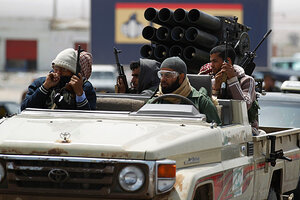One thing is clear in Libya: Rebels can't advance without air support
If international powers narrow their interpretation of the UN mandate in Libya, rebels would have a much harder time making headway against Muammar Qaddafi's forces.

Libyan rebels flee after forces loyal to Muammar Qaddafi attacked them near Brega in eastern Libya on March 30.
Finbarr O'Reilly/Reuters
Benghazi, Libya
In downtown Benghazi, a billboard erected in late February insisted in English, “No to foreign intervention. The Libyan people can do this on their own.” That was torn down by rebels last week in a tacit acknowledgment that actually, the rebels can't do this on their own.
Indeed, three things have become clear in the international air campaign to protect Libya’s uprising against Muammar Qaddafi that is now in its 12th day:
- Foreign airstrikes decisively tip the battlefield in the untrained, if eager, rebel army’s direction;
- The rebels can advance easily along the sparsely inhabited desert running west towards Sirte, Qaddafi’s hometown, as long as foreign warplanes are plowing the road in front of them;
- Absent that air support, Qaddafi’s army drives them relentlessly back.
We’ve seen all of that in the past two weeks since the United Nations cleared the way for airstrikes. The armored column that threatened to overrun Benghazi, the rebel capital, was devastated by a few hours of attacks from French Mirage fighter jets on March 19.
After British Tornado aircraft destroyed at least 20 tanks, rocket launchers, and armored personnel carriers around Ajdabiya at the end of last week, the rebels finally broke the siege of that town, the last major population center before Sirte, 300 miles west.
The rebels then began their second surge across the desert, making it to the outskirts of Sirte – Qaddafi's hometown – on Sunday in their pickup trucks and Chevy sedans behind an advancing curtain of airstrikes that Qaddafi’s forces had no answer for. Ras Lanuf and Bin Jawwad, two towns they lost before the UN Security Council took action, were easily reclaimed for “Free Libya.”
But then yesterday, for whatever reason, the sorties that had disrupted Qaddafi’s supply lines and made it impossible to move his forces east dried up.
Government troops began to flank the disorganized rebels at desert crossroads, and began to pepper them with the same rocket and mortar fire that drove them back earlier this month.
At least 10 rebels have died in the fighting around Ras Lanuf and the hamlet of Uqayla, which is further east, in the past 24 hours, according to the hospitals at Ras Lanuf and Ajdabiya.
RELATED: A primer on Libya's key cities
Airstrikes dried up yesterday. Why?
The reasons for the lack of support yesterday were unclear, though they followed a confusing speech in which President Barack Obama said international action here was not about “regime change” while also insisting that Qaddafi must leave power.
The UN mandate to “protect civilians” had been interpreted fairly expansively in its first week, with Qaddafi’s tanks destroyed in clearly defensive positions around Ajdabiya. But at least for a day, the mission appeared to have shifted.
Qaddafi certainly has more support in his hometown of Sirte than in Ajdabiya, where most of the population appeared to be in open rebellion against his troops, and it could be that the US or some of its NATO allies decided that assisting a rebel assault on that town would be bending the UN resolution to the point of breaking.
Or it could simply be that the weather was bad yesterday (there are frequent localized sandstorms here), or Qaddafi’s people have started using pickups and other civilian vehicles that make them harder to distinguish from the air.
This morning, rebels at the front reported renewed French airstrikes – France has been the most aggressive of the NATO members in supporting the rebellion – around Uqayla.
Libya's de facto partition enforced by air
For now the de facto partition of the country remains enforced by foreign airpower, with the line drawn somewhere in the desert between Ajdabiya and Sirte.
With the defenders of Sirte well dug in, definitely more competent and for now seemingly motivated, it’s hard to see the rebels taking that town without an assault from the air. The Pentagon says it now has AC-130 and A-10 Warthogs – slow flying planes whose cannons are designed for close air support – flying in the area, but it isn’t clear if they’ve been used yet.
It’s possible that Qaddafi’s loyalists in Sirte may abandon him, which could bring the war to an end quickly. Financial sanctions and a lack of fuel supplies are just starting to bite in Libya’s west. They could push people around Qaddafi to reconsider their support.
But there are no signs of that yet. For now, the stalemate in the desert seems certain to persist unless offensive air operations are resumed.
